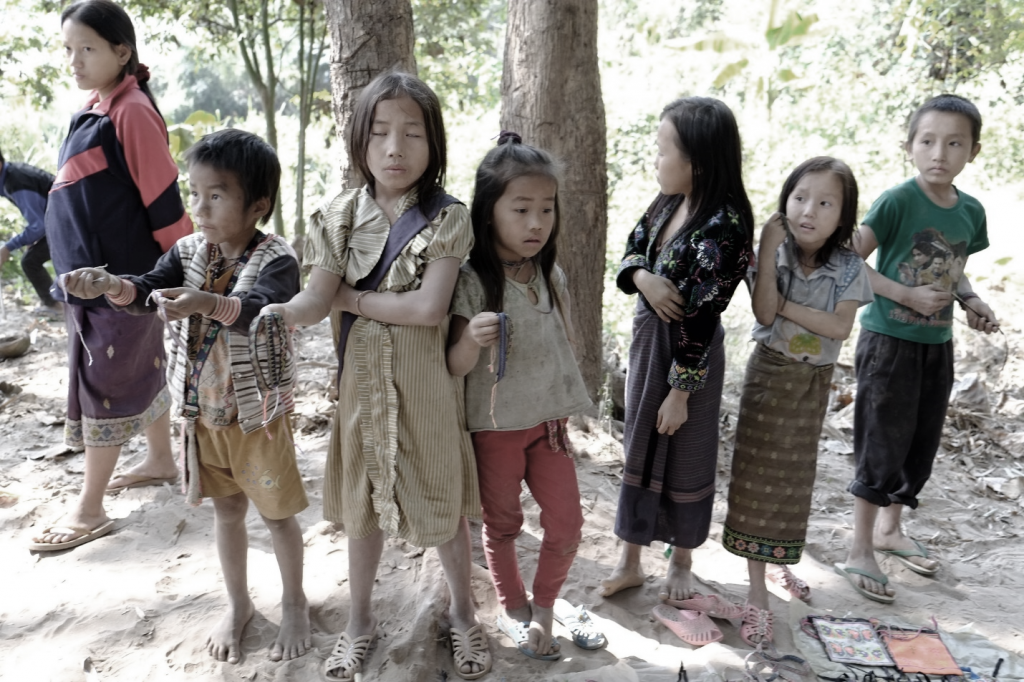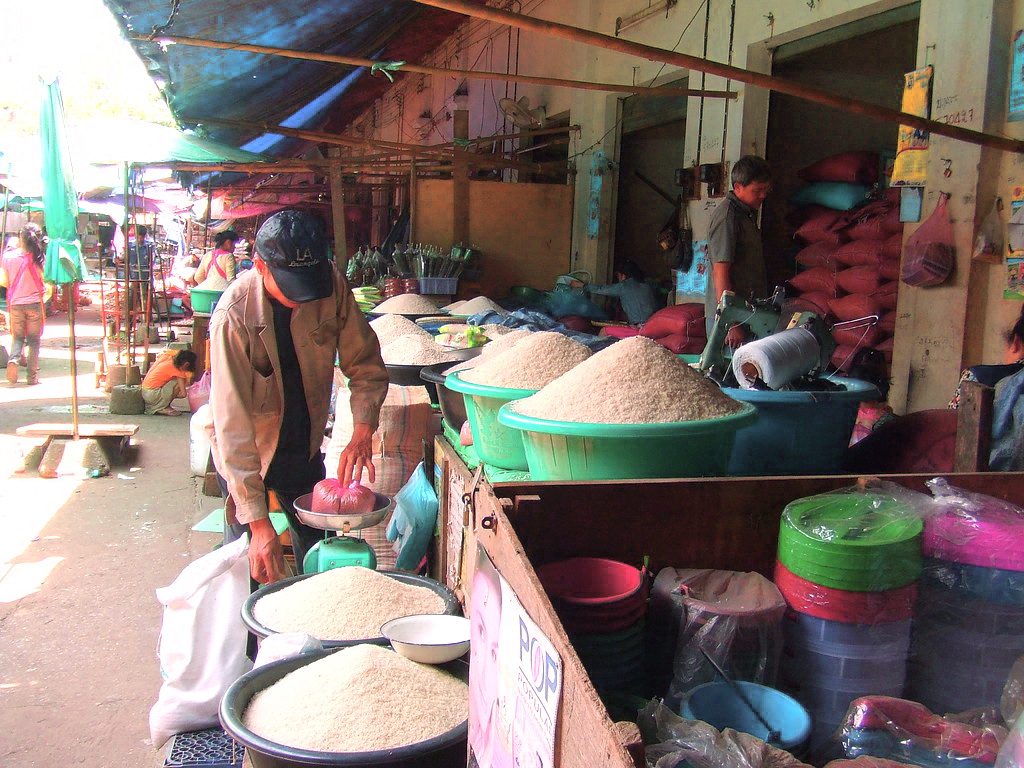ເປົ້າໝາຍການພັດທະນາແບບຍືນຍົງ 2 (SDG 2) – ‘ລຶບລ້າງຄວາມອຶດຫິວ’ ແນໃສ່ການລຶບລ້າງຄວາມອຶດຫົວ, ບັນລຸຄວາມໝັ້ນຄົງດ້ານສະບຽງອາຫານ ແລະ ປັບປຸງດ້ານໂພຊະນາການ, ແລະ ສົ່ງເສີມການກະສິກຳແບບຍືນຍົງ.1 SDG 2 ລວມມີ 8 ເປົ້າໝາຍ ແລະ 14 ຕົວຊີ້ວັດ. ເປົ້າໝາຍ 2.1-2.2 ແນໃສ່ລຶບລ້າງຄວາມອຶດຫິວ ແລະ ຮັບປະກັນການເຂົ້າເຖິງແຫຼ່ງສະບຽງອາຫານທີ່ຄົບຖ້ວນ ແລະ ພຽງພໍສຳລັບກຸ່ມອ່ອນໄຫວ, ໂດຍສະເພາະແມ່ນເດັກນ້ອຍ, ສ່ວນເປົ້າໝາຍ 2.3-2.4 ແນໃສ່ການຮັບປະກັນດ້ານການຜະລິດ, ຜະລິດຕະພາບ ແລະ ຄວາມຍືນຍົງຂອງການຜະລິດສະບຽງອາຫານ, ໂດຍສະເພາະພາຍໃຕ້ສະພາບອາກາດທີ່ຮ້າຍແຮງ. ເປົ້າໝາຍທີ 2.5 ແນໃສ່ຮັບປະກັນຄວາມຫຼາກຫຼາຍຂອງແຫຼ່ງອາຫານ ແລະ ແນວພັນ; ແລະ ເປົ້າໝາຍທີ 2.A-2.C ແມ່ນກ່ຽວກັບນະໂຍບາຍ ແລະ ມາດຕະການເພື່ອສົ່ງເສີມການລົງທຶນ, ການຕະຫຼາດ, ຄວາມສາມາດໃນການຂົນສົ່ງ ແລະ ຊົມໃຊ້ ໃນການຜະລິດສະບຽງອາຫານ.2
ຈາກເປົ້າໝາຍການພັດທະນາແຫ່ງສະຫະສະວັດສູ່ SDG 2
ເປົ້າໝາຍການພັດທະນາແຫ່ງສະຫະສະວັດ (MDGs) ແມ່ນເປົ້າໝາຍການພັດທະນາໂລກ ເຊິ່ງມີການຮັບຮອງເອົາໃນປີ 2000, ແລະ ມີຄາດໝາຍສູ້ຊົນໃຫ້ສຳເລັດພາຍໃນປີ 2015 ເພື່ອເປັນແນວທາງການພັດທະນາສຳລັບລັດຖະບານ ແລະ ບັນດາຄູ່ຮ່ວມພັດທະນາ. MDGs ລວມມີ 8 ເປົ້າໝາຍການປະຕິບັດ ເຊິ່ງມີຈຸດປະສົງແນໃສ່ລຶບລ້າງຄວາມທຸກຍາກ ແລະ ຍົກລະດັບມາດຕະຖານການດຳລົງຊີວິດໃນທົ່ວໂລກ. MDGs ແນໃສ່ການພັດທະນາວຽກງານການສຶກສາ, ຄວາມສະເໝີພາບທາງເພດ, ສາທາລະນະສຸກ, ສິ່ງແວດລ້ອມ ແລະ ການຮ່ວມມືເພື່ອການພັດທະນາສາກົນ. ກ່ອນສິ້ນສຸດວາລະໃນການຈັດປະຕິບັດ MDGs, ເປົ້າໝາຍການພັດທະນາແບບຍືນຍົງ (SDGs) ໄດ້ຮັບການສ້າງຕັ້ງຂຶ້ນເພື່ອສານຕໍ່ຜົນສຳເລັດ ແລະ ສິ່ງທ້າທາຍໃນການປະຕິບັດ MDGs. ໂດຍການເສີມຂະຫຍາຍ MDGs ທີ່ສ່ວນໃຫຍ່ແມ່ນເນັ້ນໃສ່ການພັດທະນາທາງດ້ານສັງຄົມ, SDGs ໄດ້ລວມເອົາທຸກໆຂົງເຂດການພັດທະນາແບບຍືນຍົງ ເຊັ່ນ ດ້ານເສດຖະກິດ, ສັງຄົມ ແລະ ສິ່ງແວດລ້ອມ. SDGs ແມ່ນເປົ້າໝາຍການພັດທະນາລວມລະດັບໂລກ ທີ່ສາມາດນຳໃຊ້ໃນທຸກໆປະເທດ ໂດຍບໍ່ຈຳແນກລະດັບການພັດທະນາຂອງແຕ່ລະປະເທດ ເພື່ອກ້າວໄປສູ່ການພັດທະນາແບບຍືນຍົງຢ່າງແທ້ຈິງ.3

ເດັກນ້ອຍຊາວບ້ານ, ສປປ ລາວ. ຮູບຖ່າຍ ໂດຍ David Lewis. ວັນທີ 27 ມັງກອນ 2014. ລິຂະສິດ: David Lewis
SDG 2 ແມ່ນກ່ຽວເນື່ອງມາຈາກເປົ້າໝາຍ MDG #1, “ລຶບລ້າງຄວາມທຸກຍາກ ແລະ ຄວາມອຶດຫິວ”, ໂດຍສະເພາະແມ່ນເປົ້າໝາຍ 1.C – ຫຼຸດຜ່ອນອັດຕາຜູ້ອຶດຫິວໃຫ້ໄດ້ເຄິ່ງໜຶ່ງໃນລະຫວ່າງປີ 1990 ແລະ 2015.4 ກ່ຽວກັບເປົ້າໝາຍ MDG ເປົ້າໝາຍທີ 1.C, ສປປ ລາວໄດ້ບັນລຸເປົ້າໝາຍຫຼຸດຜ່ອນອັດຕາຄົນອຶດຫິວລົງເຄິ່ງໜຶ່ງ, ໂດຍສາມາດຫຼຸດຜ່ອນຈຳນວນປະຊາກອນທີ່ມີຄວາມບົກພ່ອງທາງໂພຊະນາການຈາກ 42.8% ໃນປີ 1990-92 ມາເປັນ 18.5% ໃນປີ 2014-16.5
ເຖິງແມ່ນວ່າລາວຈະມີການປັບປຸງດ້ານຄວາມອຶດຫິວໃນຊ່ວງທົດສະວັດຜ່ານມາ, ລາວຍັງຄົງຖືກຈັດຢູ່ໃນອັນດັບ “ຮ້າຍແຮງ” ດ້ານຄວາມອຶດຫິວ ຕາມດັດສະນີຄວາມອຶດຫິວໂລກ 2018. ດັດສະນີຄວາມອຶດຫິວໂລກ (GHI) ແມ່ນເຄື່ອງມືວັດແທກທີ່ນຳໃຊ້ເຂົ້າໃນການປະເມີນຄວາມອຶດຫິວລະດັບໂລກ ແລະ ລະດັບປະເທດ, ເຊິ່ງກຳນົດຈາກສີ່ຕົວຊີ້ວັດຄື: ການຂາດສານອາຫານ, ພາວະເດັກເຕ້ຍ, ພາວະເດັກຈ່ອຍ, ແລະ ອັດຕາການຕາຍຂອງເດັກ. ເຊິ່ງຄະແນນດັດສະນິທີ່ສູງ ໝາຍເຖິງສະຖານະຄວາມອຶດຫິວທີ່ຮ້າຍແຮງ. ຕາມບົດລາຍງານ GHI 2018 , ລາວແມ່ນຢູ່ໃນອັນດັບທີ 83 ໃນ 119 ປະເທດໃນການຈັດອັນດັບ, ມີຄະແນນ 25.3 ຄະແນນ, ຈັດເປັນອັນດັບຕ່ຳສຸດທຽບກັບບັນດາປະເທດເພື່ອນບ້ານເຊັ່ນ ປະເທດກຳປູເຈຍຢູ່ອັນດັບທີ 78 (ມີ 23.7 ຄະແນນ), ປະເທດມຽນມາຢູ່ທີ 68 (ມີ 20.1 ຄະແນນ), ປະເທດຫວຽດນາມຢູ່ອັນດັບ 64 (ມີ16.0 ຄະແນນ), ແລະ ປະເທດໄທຢູ່ອັນດັບ 44 (ມີ 10.4 ຄະແນນ).6
ໃນຂະນະທີ່ຕົວຊີ້ວັດທາງດ້ານໂພຊະນາການຫຼາຍຢ່າງໄດ້ຮັບການປັບປຸງໃນຊຸມປີຜ່ານມາ, ຕົວເລກໃນປະຈຸບັນກໍຍັງຖືວ່າຕ່ຳ. ຕາມການສຳຫຼວດຕົວຊີ້ວັດທາງສັງຄົມຂອງລາວ (LSIS) ໃນປີ 2011/2012, ເດັກອາຍຸຫຼຸດ 5 ປີເຖິງ 44% ຈັດຢູ່ໃນເກນເຕ້ຍ, 27% ຢູ່ໃນພາວະນ້ຳໜັກຫຼຸດເກນ; ແລະ 6% ມີພາວະຈ່ອຍ.7 ມາເຖິງສົກປີ 2016/17 ຕາມການສຳຫຼວດຕົວຊີ້ວັດທາງສັງຄົມຂອງລາວ (LSIS) 2, ອັດຕາເດັກເຕ້ຍອາຍຸບໍ່ເກີນຫ້າປີ ໄດ້ຫຼຸດລົງເຫຼືອ 33%, ເດັກນ້ຳໜັກຫຼຸດເກນຫຼຸດລົງເຫຼືອ 21%, ສ່ວນເດັກຈ່ອຍເພີ່ມຂຶ້ນເປັນ 9%. ນອກນີ້ ອັດຕາຄວາມແຕກຕ່າງແມ່ນຍັງມີສູງເມື່ອສົມທຽບໃນແຕ່ລະແຂວງ ແລະ ສົມທຽບຕາມປັດໃຈທາງສັງຄົມຕ່າງໆ. ໃນການສຳຫຼວດຄັ້ງທີສອງ, ອັດຕາເດັກເຕ້ຍໃນນະຄອນວຽງຈັນແມ່ນມີຕ່ຳສຸດ (13.8%) ແລະ ສູງສຸດແມ່ນຢູ່ແຂວງຜົ້ງສາລີ (5%). ເດັກນ້ອຍໃນຊົນນະບົດທີ່ບໍ່ມີຖະໜົນເຂົ້າເຖິງ ເຊິ່ງແມ່ຂາດໂອກາດທາງດ້ານການສຶກສາ ແລະ ມາຈາກກຸ່ມທີ່ທຸກຍາກທີ່ສຸດ ມີອັດຕາເດັກເຕ້ຍສູງກວ່າສອງເຖິງສາມເທົ່າທຽບກັບເຂດຕົວເມືອງ ເຊິ່ງແມ່ມີການສຶກສາທີ່ສູງ ແລະ ມາຈາກຄອບຄົວຮັ່ງມີ.8
ອັດຕາການລ້ຽງເດັກດ້ວຍນົມແມ່ໃນລາວຍັງຕ່ຳ ແຕ່ກໍມີການພັດທະນາ. ອັດຕາການລ້ຽງເດັກດ້ວຍນົມແມ່ໃນປີ 2017 ແມ່ນຢູ່ທີ່ 50.1%, ໃນຂະນະທີ່ໃນປີ 2011 (LSIS I) ອັດຕາແມ່ນຢູ່ທີ່ 39%. ອັດຕາສ່ວນເດັກນ້ອຍອາຍຸ 6-23 ເດືອນທີ່ໄດ້ຮັບສານອາຫານຄົບຖ້ວນເພີ່ມຂຶ້ນຈາກ 43% ໃນປີ 2011 ເປັນ 69% ໃນປີ 2017. ອັດຕາການລ້ຽງລູກດ້ວຍນົມແມ່ໃນຊ່ວງຫົກເດືອນທຳອິດ (ຕາມຄຳແນະນຳເພື່ອສຸຂະພາບເດັກຂອງອົງການອະນາໄມໂລກ) ຍັງຕ່ຳ ເຖິງຈະເພີ່ມຂຶ້ນທຽບກັບຫ້າປີຫຼັງ ຈາກ 40.1% ໃນປີ 2011 ມາເປັນ 44.9% ໃນປີ 2017.9
ໃນປີ 2011/2012, ປະຊາກອນຈຳນວນ 89 ເປີເຊັນມີການບໍລິໂພກອາຫານໃນລະດັບທີ່ພຽງພໍກັບຄວາມຕ້ອງການ, ສ່ວນອີກ 11 ເປີເຊັນໃນຊົນນະບົດ ແມ່ນຍັງຢູ່ໃນລະດັບຕ່ຳ ຫຼື ປານກາງ. ເມື່ອທຽບກັບກຸ່ມທີ່ມີການບໍລິໂພກທີ່ເໝາະສົມ, ຄົວເຮືອນທີ່ມີການບໍລິໂພກຕາມເກນໃນລະດັບຕ່ຳ ຫຼື ປານກາງ ມີທ່າອ່ຽງມີດິນທຳການຜະລິດໜ້ອຍ, ສ້າງລາຍຮັບຈາກການປູກພືດທຳເງິນ, ມີການເຂົ້າເຖິງພືດຜັກສວນຄົວໜ້ອຍ ແລະ ມີຫົວໜ້າຄອບຄົວທີ່ຂາດໂອກາດດ້ານການສຶກສາ.10
ສາເຫດຂອງສະພາວະທຸພະໂພຊະນາການໃນເດັກແມ່ນຍ້ອນຄວາມບໍ່ພຽງພໍດ້ານສະບຽງອາຫານ ແລະ ການກິນອາຫານທີ່ບໍ່ມີໂພຊະນາການຄົບຖ້ວນ, ເຊິ່ງກ່ຽວເນື່ອງກັບປະເພນີການລ້ຽງດູ ແລະ ປ້ອນອາຫານທີ່ມີຄຸນນະພາບຕ່ຳ ແລະ ຍ້ອນພະຍາດຕິດແປດ. ປັດໃຈຫຼັກທີ່ນຳໄປສູ່ການຂາດສານອາຫານໃນເດັກ ລວມມີ ບັນຫາດ້ານສຸຂະພາບ ແລະ ໂພຊະນາການຂອງແມ່, ການຖືພາໃນໄວລຸ້ນ, ລະດັບການສຶກສາຂອງແມ່ຍິງມີຕ່ຳ, ຄວາມບໍ່ໝັ້ນຄົງດ້ານສະບຽງອາຫານ, ການຮັກສາຄວາມສະອາດມີຕ່ຳ, ແລະ ການນຳໃຊ້ແຫຼ່ງນ້ຳ ແລະ ສຸຂາພິບານທີ່ບໍ່ປອດໄພ.11
ການຫັນ SDG 2 ເຂົ້າສູ່ແຜນນະໂຍບາຍພາຍໃນລາວ
ເພື່ອແກ້ໄຂບັນຫາດັ່ງກ່າວ ແລະ ສືບຕໍ່ວຽກງານການລຶບລ້າງຄວາມອຶດຫິວ, ລາວໄດ້ທຳການຜັນຂະຫຍາຍ SDG 2 ເຂົ້າສູ່ແຜນນະໂຍບາຍພາຍໃນປະເທດ ເຊິ່ງອາດແບ່ງເປັນ 4 ຂົງເຂດວຽກງານຄື: (i) ການຜະລິດສະບຽງອາຫານແບບຍືນຍົງ, ການປັບປຸງຄວາມສາມາດດ້ານການຜະລິດ, ແລະ ການຜະລິດກະສິກຳທີ່ສາມາດຮອງຮັບຕໍ່ການປ່ຽນແປງ (ເປົ້າໝາຍ 2.3 ແລະ 2.4); (ii) ບັນລຸການເຂົ້າເຖິງແຫຼ່ງອາຫານທີ່ປອດໄພ, ມີໂພຊະນາການຄົບຖ້ວນ ແລະ ພຽງພໍສຳລັບທຸກຄົນຕະຫຼອດປີ (ເປົ້າໝາຍ 2.1); (iii) ການປັບປຸງດ້ານໂພຊະນາການສຳລັບກຸ່ມສ່ຽງ (ເປົ້າໝາຍ 2.2); ແລະ (iv) ການປັບປຸງການຄຸ້ມຄອງຄວາມຫຼາຍຫຼາຍຂອງແນວພັນ (ເປົ້າໝາຍ 2.5).12
ການຫັນ SDGs ເຂົ້າສູ່ນະໂຍບາຍພາຍໃນແມ່ນດຳເນີນໂດຍການລວມເປົ້າໝາຍ ແລະ ຕົວຊີ້ວັດເພື່ອການຕິດຕາມ ແລະ ປະເມີນຜົນຂອງແຜນພັດທະນາເສດຖະກິດ-ສັງຄົມແຫ່ງຊາດ (NSEDP) ໃຫ້ເຂົ້າກັບເປົ້າໝາຍ ແລະ ຕົວຊີ້ວັດຂອງ SDGs ເພື່ອສະດວກໃນການຈັດຕັ້ງປະຕິບັດ ແລະ ການຕິດຕາມທັງສອງເປົ້າໝາຍ.13 ສຳລັບ SDG 2, ຕົວຊີ້ວັດຂອງເປົ້າໝາຍດັ່ງກ່າວໄດ້ຖືກລວມເຂົ້າກັບເປົ້າໝາຍລວມຂອງແຜນພັດທະນາເສດຖະກິດ-ສັງຄົມແຫ່ງຊາດ ຄັ້ງທີ 8 2016-2020, ໂດຍສະເພາະແມ່ນເປົ້າໝາຍທີ 2, ຄາດໝາຍສູ້ຊົນທີ 2 – ການຮັບປະກັນຄວາມໝັ້ນຄົງດ້ານສະບຽງອາຫານ ແລະ ການຫຼຸດຜ່ອນການຂາດສານອາຫານ. ເປົ້າໝາຍດັ່ງກ່າວແມ່ນແນໃສ່ຫຼຸດຜ່ອນຄວາມທຸກຍາກດ້ານສະບຽງອາຫານ, ການຂາດສານອາຫານ, ແລະ ການປັບປຸງຊີວິດການເປັນຢູ່ຂອງປະຊາຊົນ ໂດຍການສົ່ງເສີມການຜະລິດສະບຽງອາຫານ.14
ການຈັດຕັ້ງປະຕິບັດ SDG 2 ໃນລາວ
ລາວໄດ້ດຳເນີນການຕ້ານຄວາມອຶດຫິວ ແລະ ການຂາດສານອາຫານ ໂດຍການເຂົ້າຮ່ວມໃນການທ້າທາຍເພື່ອລຶບລ້າງຄວາມອຶດຫິວໂລກຂອງອົງການສະຫະປະຊາຊາດ ໃນເດືອນພຶດສະພາ 2015, ເຊິ່ງປະເທດທີ່ເຂົ້າຮ່ວມຕ້ອງໃຫ້ສຳເລັດການລຶບລ້າງຄວາມບໍ່ໝັ້ນຄົງດ້ານສະບຽງອາຫານ ແລະ ການຂາດໂພຊະນາການພາຍໃນປີ 2025. ນອກນີ້ ບັນດານະໂຍບາຍພາຍໃຕ້ແຜນ NSEDP ຄັ້ງທີ 8 ກໍຍັງເປັນການປະກອບສ່ວນໃນການຈັດຕັ້ງປະຕິບັດ SDG. ຍຸດທະສາດການພັດທະນາຂະແໜງກະສິກຳເຖິງປີ 2025 ແລະ ວິໄສທັດປີ 2030 ແນໃສ່ຮັບປະກັນຄວາມໝັ້ນຄົງດ້ານສະບຽງອາຫານຜ່ານການກະສິກຳແບບຍືນຍົງ ແລະ ສາມາດຮອງຮັບຕໍ່ການປ່ຽນແປງ ເຊິ່ງປະກອບສ່ວນຕໍ່ການຂະຫຍາຍຕົວດ້ານເສດຖະກິດ, ການຫັນເປັນອຸດສາຫະກຳ ແລະ ທັນສະໄໝ. ເປົ້າໝາຍລວມແມ່ນແນໃສ່ເພີ່ມທະວີການຜະລິດກະສິກຳ, ປັບປຸງການແຂ່ງຂັນດ້ານຄຸນນະພາບ, ການບັງຄັບໃຊ້ມາດຕະຖານ ແລະ ລະບຽບການ, ແລະ ຮັບປະກັນຄວາມໝັ້ນຄົງ ແລະ ປອດໄພດ້ານສະບຽງອາຫານຜ່ານການປະຕິບັດທີ່ສອງຄ່ອງກັບມາດຕະຖານ SPS (ສຸຂາພິບານ ແລະ ສຸຂະອະນາໄມ) ພື້ນຖານ. ຍຸດທະສາດຂະແໜງໂພຊະນາການແຫ່ງຊາດເຖິງປີ 2025 ແລະ ແຜນດຳເນີນງານປີ 2016-2020 ເນັ້ນໃສ່ການຕອບໂຕ້ຕໍ່ການຂາດສານອາຫານຈາກຫຼາຍພາກສ່ວນ ດ້ວຍການແຊກແຊງສະເພາະທີ່ຄອບຄຸມພື້ນທີ່ທີ່ມີຄວາມສ່ຽງສູງ. ລັດຖະບານຍັງມີການຜັນຂະຫຍາຍວິທີການ “1,000 ມື້ທຳອິດ” (ນັບແຕ່ວັນເກີດເຖິງອາຍຸສອງປີ) ດ້ວຍການແຊກແຊງເພື່ອການປ່ຽນແປງດ້ານພຶດຕະກຳ.15

ຮ້ານຂາຍເຂົ້າໃນວຽງຈັນ, ສປປ ລາວ. ຮູບຖ່າຍ ໂດຍ IRRI-Lao PDR. ວັນທີ 19 ເມສາ 2011. ລິຂະສິດ: CC BY-NC-SA 2.0
ຄຽງຄູ່ກັບພາລະກິດຂອງລັດຖະບານ, ຄູ່ຮ່ວມພັດທະນາກໍມີການປະກອບສ່ວນໃນການປັບປຸງວຽກງານດ້ານກະສິກຳ ແລະ ໂພຊະນາການຂອງລາວ. ຕົວຢ່າງ ໂຄງການອາຫານໂຮງຮຽນໃນ ສປປ ລາວ ພາຍໃຕ້ການສະໜັບສະໜູນຂອງສະຫະລັດອາເມລິກາ (US) ແລະ ອົງການອາຫານໂລກ (WFP) ເຊິ່ງມີທຶນຈຳນວນ US$47 ລ້ານໂດລາ ສຳລັບປີ 2008 ເຖິງປີ 2017. ໂຄງການດັ່ງກ່າວມີການແຈກຢາຍອາຫານຫວ່າງພາກເຊົ້າ ແລະ ອາຫານທ່ຽງສຳລັບເດັກນ້ອຍ 150,000 ຄົນໃນໂຮງຮຽນ 1,500 ແຫ່ງທົ່ວປະເທດ, ໂດຍສະເພາະແມ່ນສຳລັບເດັກກຸ່ມສ່ຽງ, ແນໃສ່ຫຼຸດຜ່ອນຄວາມອຶດຫິວ ແລະ ສົ່ງເສີມຄວາມຮູ້ໜັງສື ແລະ ການສຶກສາຊັ້ນປະຖົມ.16
ໂດຍສະເພາະໃນດ້ານໂພຊະນາການ ແລະ ຄວາມໝັ້ນຄົງດ້ານສະບຽງອາຫານ, ສປປ ລາວສາມາດປະຕິບັດໄດ້ດີໃນການຜະລິດສະບຽງອາຫານ; ການຜະລິດກະສິກຳສາມາດບັນລຸ ຫຼື ເກີນໃນທຸກໆລະດັບຄາດໝາຍການຜະລິດສະບຽງອາຫານຕໍ່ຫົວຄົນ. ໃນປີ 2017 ການຜະລິດເຂົ້າແມ່ນເຮັດໄດ້ສອງເທົ່າຂອງເປົ້າໝາຍການບໍລິໂພກແຫ່ງຊາດສຳລັບປີ 2020, ການປູກຜັກແມ່ນເຮັດໄດ້ສີ່ເທົ່າ, ແລະ ການຜະລິດໝາກໄມ້ແມ່ນໄດ້ເຈັດເທົ່າຂອງເປົ້າໝາຍການບໍລິໂພກ. ຄຸນນະພາບ ແລະ ຄວາມຫຼາກຫຼາຍຂອງສະບຽງອາຫານນັບມື້ນັບສ້າງພື້ນຖານທີ່ດີທາງດ້ານໂພຊະນາການ, ເຮັດໃຫ້ການຈັດສັນສະບຽງອາຫານມີຄວາມເໝາະສົມ.17

ແຫຼ່ງຂໍ້ມູນ: ອົງການສະຫະປະຊາຊາດປະຈຳ ສປປ ລາວ
ການຕິດຕາມການຈັດຕັ້ງປະຕິບັດ SDG 2 ໃນລາວ
ເປົ້າໝາຍ SDG 2 ກ່ຽວກັບໂພຊະນາການ (2.1 ແລະ 2.2) ສາມາດຕິດຕາມໄດ້ຈາກໃບດຸ່ນດ່ຽງດ້ານສະບຽງອາຫານ ແລະ ການບໍລິໂພກຂອງອົງການອາຫານ ແລະ ການກະເສດສະຫະປະຊາຊາດໃນທຸກໆສາມປີ. ນອກນີ້ ຍັງສາມາດວັດແທກໂດຍນຳໃຊ້ ການສຳຫຼວດການໃຊ້ຈ່າຍ ແລະ ການບໍລິໂພກໃນຄົວເຮືອນ (LECS) ໃນຮອບຫ້າປີ ເຊິ່ງເກັບກຳອັດຕາສ່ວນປະຊາກອນທີ່ຫຼຸດເກນມາດຕະຖານຄວາມທຸກຍາກດ້ານອາຫານ ນັ້ນກໍຄືຜູ້ທີ່ບໍລິໂພກຕ່ຳກວ່າລະດັບຕາມຄວາມຕ້ອງການພະລັງງານຕ່ຳສຸດ 2,100 kcal/ຄົນ/ວັນ. LECS ຍັງວັດແທກລະດັບຄວາມບໍ່ໝັ້ນຄົງດ້ານສະບຽງອາຫານລະດັບປານກາງ ຫຼື ຮ້າຍແຮງ ຂອງປະຊາກອນລາວ, ໂດຍອີງໃສ່ອັດຕາສ່ວນສະພາບຄວາມບໍ່ໝັ້ນຄົງດ້ານອາຫານ (FIES). ນອກຈາກນີ້ຍັງມີການສຳຫຼວດຕົວຊີ້ວັດດ້ານສັງຄົມໃນທຸກໆຫ້າປີ (LSIS), ເຊິ່ງເປັນການສຳຫຼວດແບບສຸ່ມຕົວຢ່າງທົ່ວປະເທດ ເພື່ອວັດແທກຄວາມຄືບໜ້າໃນການພັດທະນາດ້ານສັງຄົມຂອງປະເທດ. ສ່ວນເປົ້າໝາຍດ້ານກະສິກຳ ແລະ ໂຄງສ້າງທາງນະໂຍບາຍ (ເປົ້າໝາຍ 2.3-2.5 ແລະ 2.A-2.C), ຍັງບໍ່ມີຕົວຊີ້ວັດໃນການຕິດຕາມທີ່ພຽງພໍ. ເຊິ່ງຮຽກຮ້ອງໃຫ້ມີການພັດທະນາການສຳຫຼວດ ແລະ/ຫຼື ການສຳຫຼວດປະຊາກອນ ທີ່ແທດເໝາະກັບການວັດແທກຄວາມສາມາດໃນການຜະລິດ ແລະ ການແຈກຢາຍຂອງຂະແໜງກະສິກຳເພີ່ມຕື່ມ.18 19
ເພື່ອສົ່ງເສີມການຕິດຕາມ ແລະ ການທົບທວນການຈັດຕັ້ງປະຕິບັດ SDGs, ສປປ ລາວ ຍັງໄດ້ສ້າງບົດລາຍງານຄວາມຄືບໜ້າແບບສະໝັກໃຈ (VNR) ສະບັບທຳອິດໃນປີ 2018 ໂດຍການປຶກສາຫາລືລະຫວ່າງບັນດາກະຊວງ, ອົງການຈັດຕັ້ງລັດຖະບານ ແລະ ອຳນາດການປົກຄອງທ້ອງຖິ່ນ, ກໍຄືບັນດາຄູ່ຮ່ວມພັດທະນາ, ອົງການຈັດຕັ້ງສັງຄົມສົງເຄາະ, ແລະ ຂະແໜງການເອກະຊົນ. ບົດລາຍງານດັ່ງກ່າວໄດ້ນຳສະເໜີຜ່ານກອງປະຊຸມການເມືອງລະດັບສູງ (HLPF) 2018, ເຊິ່ງນຳສະເໜີຜົນສຳເລັດ, ສິ່ງທ້າທາຍ ແລະ ແຜນຍຸດທະສາດເພື່ອການບັນລຸເປົ້າໝາຍ ແລະ ວາລະການພັດທະນາແບບຍືນຍົງ 2030.20
ນອກຈາກບົດລາຍງານ VNR ປີ 2018, ສປປ ລາວ ຍັງມີການດຳເນີນການທົບທວນການຈັດຕັ້ງປະຕິບັດແຜນ NSEDP ຄັ້ງທີ 8 (ແລະ ເປົ້າໝາຍ SDGs ທີ່ຜັນຂະຫຍາຍສູ່ນະໂຍບາຍພາຍໃນ) ໃນກອງປະຊຸມໂຕະມົນ 2018 , ເຊິ່ງແນໃສ່ທົບທວນຜົນການຈັດຕັ້ງປະຕິບັດ NSEDP (ການຂະຫຍາຍຕົວດ້ານເສດຖະກິດແບບທົ່ວເຖິງຍືນຍົງ; ການພັດທະນາດ້ານສັງຄົມ ແລະ ຊັບພະຍາກອນມະນຸດ; ແລະ ສິ່ງແວດລ້ອມ ແລະ ການກະກຽມຮັບມືໄພພິບັດ) ກໍຄືປະເດັນຕ່າງໆທີ່ມີສ່ວນພົວພັນກ່ຽວຂ້ອງກັບໂຄງສ້າງທາງກົດໝາຍ ແລະ ການຈັດຕັ້ງປະຕິບັດ.21 22
References
- 1. ສະຫະປະຊາຊາດ. “ເປົ້າໝາຍທີ 2: ລຶບລ້າງຄວາມທຸກຍາກ.” ສືບຄົ້ນ ເມສາ 2019.
- 2. ສະຫະປະຊາຊາດ. “ເປົ້າໝາຍການພັດທະນາແບບຍືນຍົງທີ 2.” ສືບຄົ້ນ ເມສາ 2019.
- 3. ສະຫະປະຊາຊາດໃນ ສປປ ລາວ. 2017.“ຈາກເປົ້າໝາຍການພັດທະນາແຫ່ງສະຫະສະວັດ ສູ່ເປົ້າໝາຍການພັດທະນາແບບຍືນຍົງ: ການສ້າງພື້ນຖານສຳລັບປີ 2030.” ສືບຄົ້ນ ເມສາ 2019.
- 4. ສະຫະປະຊາຊາດ. 2014. “ເປົ້າໝາຍທີ 1: ລຶບລ້າງຄວາມທຸກຍາກ & ຄວາມອຶດຫິວ.” ສືບຄົ້ນ ເມສາ 2019.
- 5. ກອງທຶນພັດທະນາກະສິກຳສາກົນ, ອົງການອາຫານ ແລະ ການກະເສດສະຫະປະຊາຊາດ, ອົງການອາຫານໂລກ. 2015. “ສະຖານະຄວາມບໍ່ໝັ້ນຄົງດ້ານສະບຽງອາຫານໂລກ 2015.” ໜ້າ 46. ສືບຄົ້ນ ເມສາ 2019.
- 6. ດັດສະນີຄວາມອຶດຫິວໂລກ. 2018. “ບົດລາຍງານດັດສະນີຄວາມອຶດຫິວໂລກ 2018.” ສືບຄົ້ນ ເມສາ 2019.
- 7. ສູນສະຖິຕິແຫ່ງຊາດ. 2012. “ບົດລາຍງານການສຳຫຼວດຕົວຊີ້ວັດທາງສັງຄົມຂອງລາວ I (LSIS) 2011-12.” ສືບຄົ້ນ ເມສາ 2019.
- 8. ສູນສະຖິຕິແຫ່ງຊາດ. 2018. “ບົດລາຍງານການສຳຫຼວດຕົວຊີ້ວັດທາງສັງຄົມຂອງລາວ (LSIS II) 2017.” ສືບຄົ້ນ ເມສາ 2019.
- 9. ອ້າງອີງຊ້ຳ.
- 10. ສະຫະປະຊາຊາດໃນ ສປປ ລາວ. 2015. “ເປົ້າໝາຍການພັດທະນາແຫ່ງສະຫະສະວັດ ແລະ ບົດຮຽນສຳລັບໄລຍະຫຼັງປີ 2015: ບົດຄັດຫຍໍ້ສັງລວມ.” ສືບຄົ້ນ ເມສາ 2019.
- 11. ສະຫະປະຊາຊາດໃນ ສປປ ລາວ. 2017.“ຈາກເປົ້າໝາຍການພັດທະນາແຫ່ງສະຫະສະວັດ ສູ່ເປົ້າໝາຍການພັດທະນາແບບຍືນຍົງ: ການສ້າງພື້ນຖານສຳລັບປີ 2030.” ສືບຄົ້ນ ເມສາ 2019.
- 12. ສະຫະປະຊາຊາດໃນ ສປປ ລາວ. 2015. “ບົດຫາລື: ເປົ້າໝາຍການພັດທະນາແບບຍືນຍົງ ຕາມເນື້ອໃນຂອງສາທາລະນະລັດ ປະຊາທິປະໄຕ ປະຊາຊົນລາວ.” ສືບຄົ້ນ ເມສາ 2019.
- 13. ສະຫະປະຊາຊາດໃນ ສປປ ລາວ. 2017. “ການຕິດຕາມຄວາມຄືບໜ້າໃນການປະຕິບັດເປົ້າໝາຍການພັດທະນາແຫ່ງຊາດ ແລະ ເປົ້າໝາຍການພັດທະນາແບບຍືນຍົງ.” ສືບຄົ້ນ ເມສາ 2019.
- 14. ກະຊວງແຜນການ ແລະ ການລົງທຶນ. 2016. “ແຜນພັດທະນາເສດຖະກິດສັງຄົມແຫ່ງຊາດ ຄັ້ງທີ 8 (2016-2020).” ສືບຄົ້ນ ເມສາ 2019.
- 15. ກະຊວງແຜນການ ແລະ ການລົງທຶນ. 2018. “ຮ່າງ 3 ບົດທົບທວນກາງພາກຂອງແຜນພັດທະນາເສດຖະກິດສັງຄົມແຫ່ງຊາດຄັ້ງທີ 8, 2016—2020.” ສືບຄົ້ນ ເມສາ 2019.
- 16. ສະຖານທູດສະຫະລັດປະຈຳ ສປປ ລາວ. 2016. “ສະຫະລັດ ແລະ WFP ສະໜັບສະໜູນໂຄງການອາຫານໂຮງຮຽນໃນ ສປປລາວ.” ສືບຄົ້ນ ເມສາ 2019.
- 17. ກະຊວງແຜນການ ແລະ ການລົງທຶນ. 2018. “ຮ່າງ 3 ບົດທົບທວນກາງພາກຂອງແຜນພັດທະນາເສດຖະກິດສັງຄົມແຫ່ງຊາດຄັ້ງທີ 8, 2016—2020.” ສືບຄົ້ນ ເມສາ 2019.
- 18. ສະຫະປະຊາຊາດໃນ ສປປ ລາວ. 2017. “ການຕິດຕາມຄວາມຄືບໜ້າໃນການປະຕິບັດເປົ້າໝາຍການພັດທະນາແຫ່ງຊາດ ແລະ ເປົ້າໝາຍການພັດທະນາແບບຍືນຍົງ.” ສືບຄົ້ນ ເມສາ 2019.
- 19. ສະຫະປະຊາຊາດໃນ ສປປ ລາວ. 2017.“ຈາກເປົ້າໝາຍການພັດທະນາແຫ່ງສະຫະສະວັດ ສູ່ເປົ້າໝາຍການພັດທະນາແບບຍືນຍົງ: ການສ້າງພື້ນຖານສຳລັບປີ 2030.” ສືບຄົ້ນ ເມສາ 2019.
- 20. ລັດຖະບານແຫ່ງ ສປປ ລາວ. 2018. “ບົດທົບທວນການຈັດຕັ້ງປະຕິບັດວາລະການພັດທະນາແບບຍືນຍົງ 2030 ລະດັບຊາດໂດຍສະໝັກໃຈຂອງ ສປປ ລາວ.” ສືບຄົ້ນ ເມສາ 2019.
- 21. UNDP ໃນ ສປປ ລາວ. 2018. “ກອງປະຊຸມໂຕະມົນ 2018: “ການທົບທວນກາງພາກຂອງແຜນ NSEDP ຄັ້ງທີ 8 ແລະ ຜົນຂອງ PDNA ແມ່ນຈຸດສຳຄັນໃນການປຶກສາຫາລື.” ສືບຄົ້ນ ເມສາ 2019.
- 22. ກະຊວງແຜນການ ແລະ ການລົງທຶນ. 2018. “ຮ່າງ 3 ບົດທົບທວນກາງພາກຂອງແຜນພັດທະນາເສດຖະກິດສັງຄົມແຫ່ງຊາດຄັ້ງທີ 8, 2016—2020.” ສືບຄົ້ນ ເມສາ 2019.

